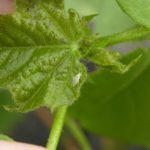 Most of the cotton in the Mid-Coast of Texas is squaring. During the squaring period, the primary insect pest of cotton in South Texas is the cotton fleahopper. This insect can cause small square abscission. The fruit loss can reduce yield and delay crop maturity.
Most of the cotton in the Mid-Coast of Texas is squaring. During the squaring period, the primary insect pest of cotton in South Texas is the cotton fleahopper. This insect can cause small square abscission. The fruit loss can reduce yield and delay crop maturity.
The cotton fleahopper adult is about 1/8 inch long, with piercing-sucking mouthparts and a flattened body (Fig. 16). Adults are active flyers; they readily flit within the cotton canopy when disturbed, which makes insect sampling a challenge. Their eggs are not visible because the adult inserts them into the cotton plant stem.
Adults are pale green to gray-green; nymphs are lighter-colored with reddish eyes.
In both the adult and nymphal stages, cotton fleahoppers suck sap from the tender portions of the cotton plant, including small squares. Pinhead size and smaller squares are the most susceptible to cotton fleahopper damage. Fleahopper feeding causes squares to die and turn dark brown. These “blasted” squares dry up and fall from the plant, leaving a characteristic scar on the fruiting site.
In cotton from Corpus to Houston, I suggest using an economic threshold of 10 cotton fleahoppers per 100 plants.
Below are preliminary results of a trial conducted in the last week. Notice the huge increase in adult numbers over the past week. We have seen this in a number of fields in the area. Some research has demonstrated that two applications may be necessary to get good control of the cotton fleahopper. We made the second application to this test Thursday. Next week I can update this information.

